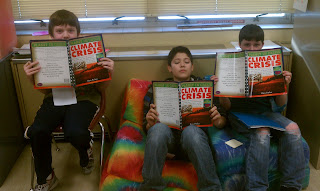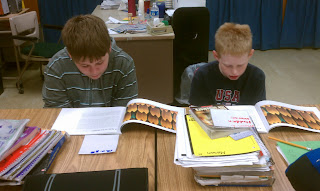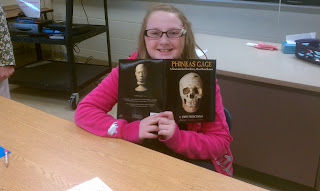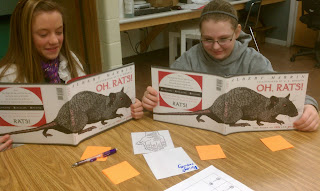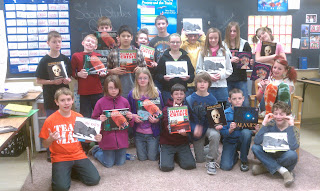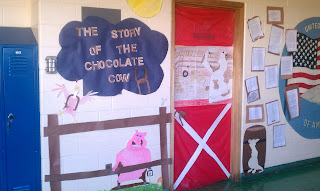June? Has it really been since June that I have written a new blog post? Well, since I am not participating in
Nanowrimo this year, I am making it a goal to get back to blogging.
The beginning of this new school year has been crazy. The middle school (grades 6-8) has made its way over to the high school building and we are nestled snugly on the second floor. I am juggling several roles: literacy coach, intervention teacher,
statewide formative assessment presenter as well as formative assessment coach to my local middle school team, not to mention mom, chauffeur, and chief cook and bottle washer at home. (Thank goodness there aren't really any bottles to wash!)
So in the near future, I'll be blogging a bit about all those things. But first, I am planning a series of posts about the multitude of apps I have on my iPad! I know there are all sorts of resources out there to find good apps, but maybe there will be something here you haven't seen before. And if you have one that I am missing, please share it in the comments!
Today's post will focus on the folder of apps that I call Teacher Tools.
Pictured above are the apps in my Teacher Tools folder. Some of them probably don't need much explanation, but I'll give a brief overview of each. For more information, you can visit the app store.
Educreations, ShowMe (in the first row) and ScreenChomp (third app in last row) are three similar apps. They all have a virtual recordable whiteboard for a teacher to record a simple lesson and upload for students to view. Between the three apps, there are capacities for sending the lessons out in email or embedding them in a website or blog. ShowMe also has the option to create student accounts...what a great way for students to show what they know!
CommonCore from Mastery Connect and EZLACore are both apps that give you quick access to the Common Core State Standards in math and ELA. (Though you'll have to find the EZMathCore app for the math standards.) I use these ones all the time. They also include the appendices of the CCSS documents. EZLACore allows the user to take notes for each standard and to email those notes.
The last app on the first row is the Classroom Organizer from Book Source. I love this app, I just wish I could take full advantage of it. This app allows the user to scan the bar codes of books to digitize the classroom library. Then it can be used as a system for students to check those books out. I have been frustrated for years about the best way to manage my classroom library and this would be so awesome...except you need wireless internet for the scanning tool to work with your iPad, iPod, cell phone, etc. And can you believe in this day and age, my building does not have wireless internet? Even just for teachers. Feel free to commiserate with me if you are in the same boat!
I'm sure iTunes U doesn't need any explanation. If you don't know what it is, go check it out NOW! Seriously, I'll wait...
The next two apps in the second row can be used for the same purposes: Confer Lite and Teacher's Assistant Lite. These two apps would be fabulous to use if you are a classroom teacher that incorporates the formative assessment process and you've been pulling your hair out trying to find a way to manage the evidence of student learning you get from observations and conferences. With these apps, you can import or add student names and use your iPad to keep your notes. Confer Lite allows you to create student groups and flag important notes. Your notes can also be shared wirelessly or sent in email. Teacher's Assistant Lite has a couple of features that Confer Lite doesn't. Teacher's Assistant has the capability of sending out bulk emails and it has a Randomizer to use in creating groups. It has an email feature as well as links to video tutorials to help you figure out how to use it. I have to admit that I haven't used either of these apps very extensively, so I am not sure yet which one I prefer.
The Skyward app is for our school's data system, so unless your building/district uses Skyward, you probably wouldn't find much use in it. The last app in the second row is a link to Planbook.com. This online lesson plan book has a yearly cost of $12, but I think it is well worth it. And you can get price reductions if several people in your building use it. What I love the most is the ease of indicating which CCSS each lesson is addressing. I use the My List feature to keep track of the students' learning targets.
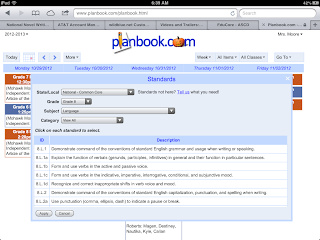 |
| This view shows the standards in drop down. Just select the ones your lesson covers! |
|
 |
| This view shows a couple of the learning targets I created to make the standards more friendly to students. |
The first app in the third row is Socrative. This is an app that can take the place of a clicker system in the classroom if students have cell phones with texting features. Once again, I think this app has great power and potential for me. But without wireless, and being in a high poverty, rural district where the majority of students do not have cell phones, it is not an app that I use.
OMJS Structures and Scholastic's Classroom Ideas To Go are two apps that give you quick ideas for activities in the classroom. OMJS has learning structures organized around the concepts of Orientation strategies, Acquire/Consolidate strategies, Reflective/Evaluative strategies, and strategies to Get Acquainted. You can select strategies based on the amount of time you have and then by how you want to group students: Individual, Pair, Foursome, Class.
In Scholastic's Classroom Ideas To Go, you set three categories and then "spin the wheel" to see a strategy. The categories are Grade (choose from spans: K-2, 3-5, 6-8, or all), Subject (math, science, language arts, social studies, the arts, life skills, classroom management, or all), and Type (group work, circle time, active, quiet, games,test prep, first weeks, fall, winter, spring, summer, outdoors, crafts, tech, decor, or all.) You can favorite the ones you really like to come back to later or search by terms as well.
Teacher Sounds by Javoid is a fun little sound board. Below is a picture to show you the different sounds the app has.
PickMe! is the last app pictured in the third row. With this app, you can import your class roster using Dropbox or manually input it. The app then allows you to randomly call on students. That is really its only function, so I haven't actually used it yet! Sometimes the old tried-and-true methods like names on popsicle sticks work just as well. But kids love the technical aspect of it!
Edmodo, in the bottom row, is a site for teachers to set up interactions with their classes that is similar to Facebook. It's another great way to cash in on our students' love of technology. Edmodo is web based as well as being an app, so students can also access it through iPods or the web via computer. Edmodo allows teachers to upload assignments and to create groups.
The last app in my Teacher Tools folder is Fluency Timer Free. I use this app to take monthly running records of my reading intervention students. The app records and times 1 minute of reading. The readings can then be sent to my email. I would love if the app developer would add the ability to save to my Evernote...then I could create a folder for each student and save their recordings for the whole year in their evernote folder and share them with parents.
There you have it! Please leave a comment if I have turned you on to an app that is new to you, or if you have a teacher tool app to share! And stay tuned next for all the apps in my Productivity folder!




















